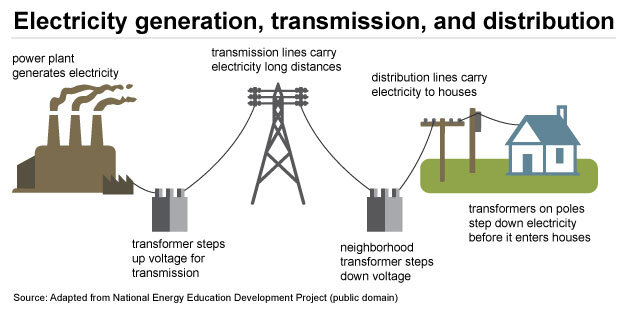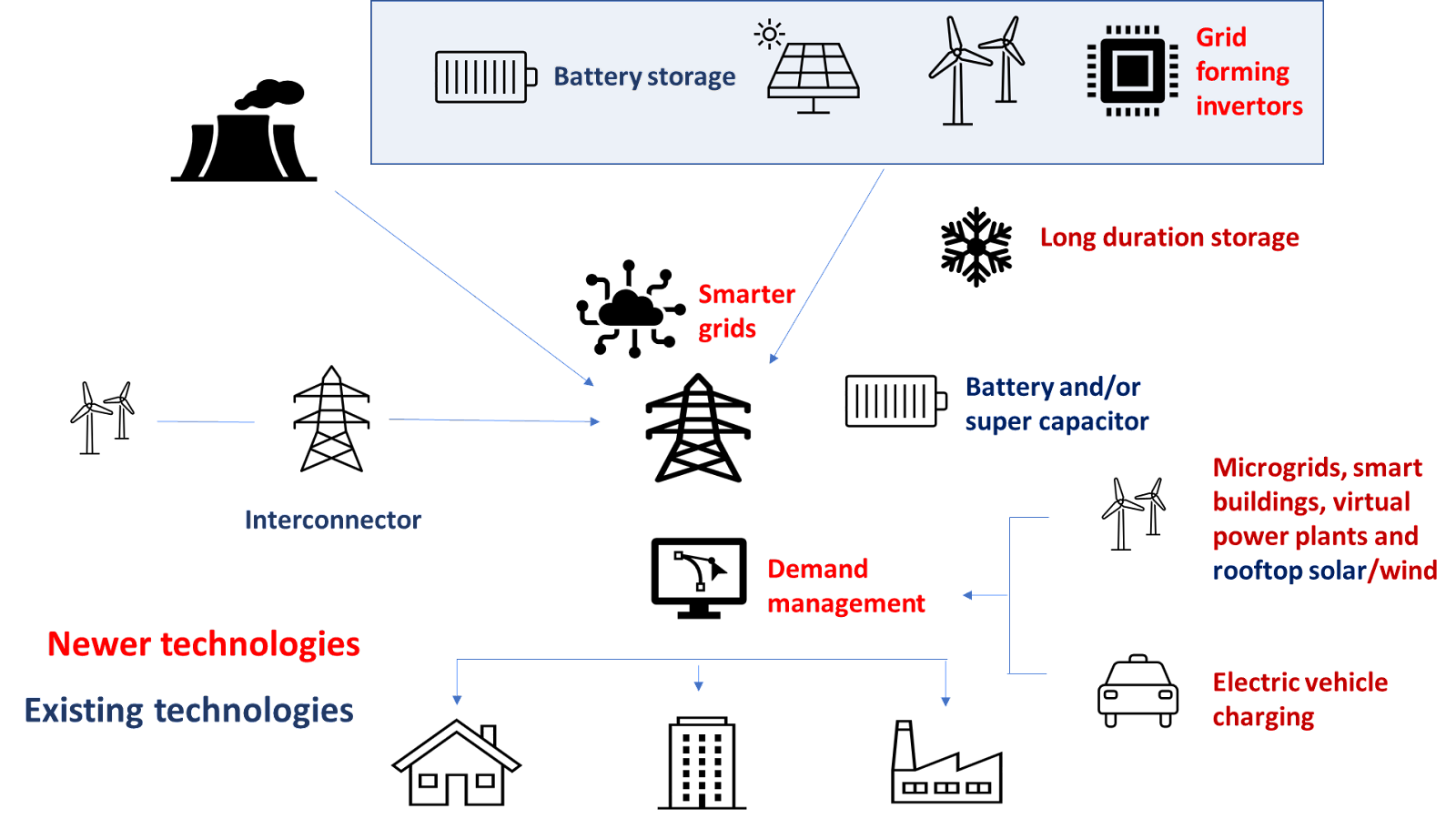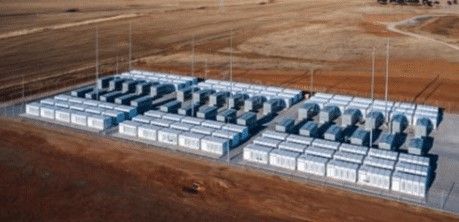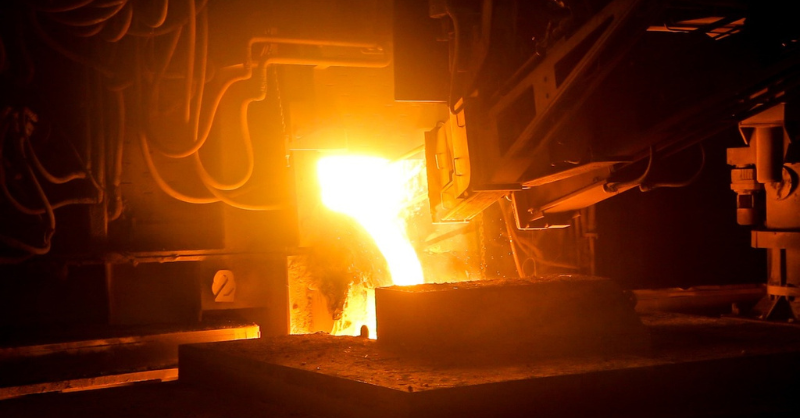
Software based electricity grid stability
The software based solutions that will make our electricity grids fit for purpose for the coming decades are a massive investment opportunity, that will also enable countries to have a realistic chance of hitting their decarbonisation and net zero targets.
Summary: As we build more variable renewable electricity generation the way our electricity grid works will need to change and change dramatically. This will be a massive disruption to the existing system. While some of it will involve building new hardware, there is a major role for smart software solutions. It's not a change that we can let happen in the background, both investment and sustainability professionals need to be actively involved.
Why this is important: Just building a lot more wind & solar generation is only part of the electricity decarbonisation solution. Yes, it helps but it will also make it harder to keep the grid stable - making sure that we all have the electricity we need, when we need it. With (almost) no blackouts. If the grid gets less stable, then we will struggle to connect up new renewable electricity. Its a vicious downward spiral.
The big theme: From a financial perspective, we need to think about what supporting investments we will need to make to allow the electricity grid to run with a higher percentage of renewables. This is going to be a massive investment theme. There are solutions, but we need to start working on them, and building them now. Without these absolutely critical investments, we will never achieve our renewable electricity targets. It's that simple.

The Detail
Why use software based solutions?
That's easy - they are frequently the lowest cost ways of enhancing grid stability. And they can often be implemented fairly quickly, at least when compared with the challenges of building say new interconnectors. And as a result, they can have a rapid financial payback. But, its important to be clear, they are part of the solution, not all of it. For this blog we set the scene, why we need software based solutions and what they do. We will start introducing some of the (investible) solution technologies in upcoming blogs.
The software based solutions that will make our electricity grids fit for purpose for the coming decades are a massive investment opportunity, that will also enable countries to have a realistic chance of hitting their decarbonisation and net zero targets. So a double win for sustainable investors.
This is Blog No 2. on this topic. Back in December 2022 we wrote (Blog 1) on hardware solutions (so interconnectors and battery storage). We recently republished Blog No 1 (so maybe Blog 1a?) - with an update to reflect recent news flow.

Why think about electricity grid stability?
If you live in North America and Europe, other than the odd time when a storm takes down power lines/electricity cables, or even more rarely shuts down power stations, you don't really think about your electricity grid. You might worry about how much your electricity costs, but most of the time you assume its going to be there.
It's a bit different in other parts of the world. When I worked in Asia Pacific as a young engineer, we got used to the electricity going off, sometimes for hours at a time. And this is still an ongoing problem in countries such as South Africa and Pakistan.
So, if our electricity grids are (mostly) pretty stable, why are we worrying about grid instability ? Well, some analysts suggest that as we shift to using more variable renewable electricity (wind and solar), our grids will become more unstable, and that blackouts will become more common. There argument sounds reasonable at first sight, they ask "what happens when the wind doesn't blow and the sun doesn't shine". But is this correct - well not really. Grid stability is clearly going to be a problem if we do nothing, but we have proven solutions to hand. We just need to implement them.
We need to change the way we think about electricity grids
A standard historic view of the electricity system is shown in the graphic below. Large centralised, mostly fossil fuel-based electricity generators produced the electricity, the grid operator handled transmission, and your local electricity utility handled distribution. And at the end, it got to you, the customer.
So, a simple system, but one that had stood the test of time for the previous 100 years or so. Thomas Edison would have recognised most of it, and he died in 1931.

This mental model dominates much of the thinking even now. Simply substitute renewables (wind & solar) for some of the fossil fuel power stations, but in many peoples minds everything else stays pretty much the same. Which is why we get the arguments about renewables not being reliable, or in more technical speak "not suitable for base load".
Which is why politicians mostly talk about building more renewables (to replace existing fossil fuel powered generation), and why sceptics talk about how renewables are too variable to support the grid. And both, in different ways, really miss the point.
Disruption is coming - and its going to be painful
For now, we will dodge the debate about what percentage of wind and solar we will likely have in our electricity generation mix, and just stick with, it's going to be a lot, probably between c.50% and 70% for many countries.
Editor note - we think for many countries 100% renewables is going to be tough, simply on the basis of cost. For most up to 90% (including hydro etc) looks achievable, but for some, the lack of interconnections will make even this tough.
The good news is that the bulk of the solutions to get us to this sort of level already exist. These include a combination of interconnectors, battery storage, transmission grid strengthening, new power software & electronics, distributed energy, and sophisticated demand management. As you can see from the graphic below, the future electricity grid system looks very different from the current system, a lot more moving parts and as a result, more complex to run.

In the first blog in the series we looked at a couple of the main hardware related solutions - interconnectors and battery storage. These bring in the electricity we need when local renewables are not generating, either from elsewhere (interconnectors) or by storing surplus electricity for release when demand exceeds supply (battery storage).
We also did a deep dive on battery storage recently, highlighting that currently most projects are being used to support grid stability, not load shifting (which is what storing surplus electricity to sell later is called). Its not that we cannot do load shifting, but so far its not yet needed (because there is not a high enough level of renewables on the grid), not supported enough by regulation, or the economics don't yet stack up (although that is changing).

Software solutions to improve grid stability
For this blog, we start to look at two of the big software driven solutions - grid management/smarter grids and demand management.
What are the technology options are how developed are they?
I know its not technically correct, but as an investor and finance person, I think about the two main technologies as:
- moving electricity demand around to reduce the peaks, and
- making best use of the infrastructure we have.
The second one is intuitively easy to understand, but the first needs a bit of explanation.
Shifting demand - we need to do it more
Most of us think we understand this, but its actually a bit more complicated than it first appears. Its not just about switching things off when we get short of electricity supply (called "when the market gets tight"), although that is part of it. It can also be a really useful tool for keeping the cost of our electricity system lower. Which is really important, especially in a world like today when many economies are struggling. Lets start with the easy one - demand management when the market gets tight.
Managing through a "tight market"
Lets start with the bit that we all probably know and understand, switching things off when the electricity market gets tight. A recent IEA tracking report looked at the two main demand management mechanisms:
- price-based programmes (or implicit demand response), which use tariffs to incentivise consumers to shift consumption, and
- incentive-based programmes (or explicit demand response), which monetise flexibility through direct payments to consumers who shift demand when specifically requested.
A good example of the first is time of day tariffs, cheap when electricity is abundant and expensive when the market is tight. Night time or economy tariffs have been around since at least the 1970's, but they are getting a second boost with the growth in smart meters.
An example of the second is the recent National Grid demand flexibility service trial, held across the 2022/2023 winter. Here the grid operator, via the electricity supplier, sent out (normally the day before) a text/email to identify the times when the system would run. The trial, for both residential and small business customers, only needed up being used on two live occasions in Jan 2023. In total, 1.6m households and businesses participated, and it was estimated that the scheme saved over 3,300MWh of electricity (enough to power 9.9m homes for an hour). Consumers needed a smart meter to participate.
These are things we should be expecting the electricity grid operators to be doing in the normal course of how they manage the grid. From an investment perspective the opportunity is around smart meters, which are a requirement for this type of demand management to work, and also the main barrier to roll out.

Smart meters not only enable the demand reduction to be measured, and hence remunerated, but they also allow the process to become automated. And, they enable individual consumers to be aggregated. This not only simplifies scaling up, but it also allows the creation of what are known as Virtual Power Plants (VPP's). These are really interesting, and so we will be coming back to these in a future blog.

Peak shifting
As we said earlier, reducing electricity usage when the market is especially tight is only part of the benefit. The much bigger win is shifting demand on a more regular basis, as this can reduce the need for expensive stand by generation and grid upgrade investment.
An important cost driver for electricity utilities is meeting peak demand. And this is not just about electricity generation, their transmission and distribution systems needs to be sized for maximum demand periods, plus a factor of safety. And this infrastructure is expensive.
To understand why this is, and how it can work, we need to understand how electricity demand changes through the day.
Welcome to the duck curve (yes, it does kind of look like a duck). If we go back 5-10 years, the net demand load on a system (I use California for my charts) was low during the night, built up during the day with peaks in the morning and then again in the early afternoon, before starting all over again. The top line (grey) in this chart shows the load situation in California in Jan 2012 (from a 2013 report). And then in 2013 things started to change - we introduced renewable electricity generation at scale.

This is how the system operator described it ...
The first ramp up of 8,000 MW (duck’s tail) occurs in the morning starting around 4:00 a.m. as people get up and go about their daily routine.
Then we have a ramp down after the sun comes up around 7:00 a.m. when conventional generation is replaced by supply from solar generation resources (producing the belly of the duck).
As the sun sets starting around 4:00 p.m., and solar generation ends, we have the second, and most significant ramp up (the arch of the duck’s neck). Immediately following this demand on the system deceases into the evening hours.
The first obvious one, is if we can shift some demand from say 6am to earlier in the morning, we can reduce the size of the peak. One example of this is using the mass of a building as a 'thermal battery'.
Researchers from the University of New South Wales in Australia have developed a method of using rooftop PV (photovoltaics) to run air conditioners and ‘pre-cool’ buildings before the rise in energy demand (e.g.to run air conditioners) as temperatures rise. They have coined the concept ‘solar pre-cooling’ and if it can be implemented (and in turn functions) as intended, could have a noticeable impact on energy consumption particularly in environments exposed to extreme temperatures.

The second, less obvious implication is ramp up, especially for the evening peak. Using the California example again ..."the existing generation fleet includes many long-start resources that need time to come on line before they can support upcoming ramps. Therefore, they must produce at some minimum power output levels in times when this electricity is not needed".
Or putting it another way, because the demand ramps up so sharply, we need to run some electricity generation (normally fossil fuel) even when we don't need the electricity they produce. This allows them to be ready to go when the renewables (in this case solar) start to drop out.
Making better use of what we (already) have
For very good reasons electricity grid specialists, like earthquake engineers (my job before I moved into finance) are conservative people. The reason is pretty obvious, for both groups the consequences of things going wrong are serious. Blackouts in one case and building collapse in the other.
But, as our analytics have got better, we can safely push the boundaries a bit more.
Financially this can be a very big deal. By better using the infrastructure we already have, we can defer new investment, make the grid more reliant and potentially get more renewables and battery storage connected up faster.
A recent (2021) study by the Brattle Group for the Watt Coalition estimated that just for Kansas and Oklahoma (two big US wind producing states), better using the infrastructure they had could mean they would be able to connect up to twice the previous level of renewables, while saving $175m a year in operating costs. Across all of the US, the total cost savings were estimated to be up to $5bn.
Grid Enhancing Technology Solutions
The technologies are known collectively as Grid Enhancing Technology Solutions (GETS) or sometimes Flexible Alternating Current Transmission Systems (FACTS). There are broadly three main approaches (our examples are from the April 2023 Brattle report). The comparative advantages of GETs include their portability and scalability (they can be added in phases without committing to a larger project), speed to deploy (they can be put into service much faster), and lower costs compared with grid upgrades (they can be deployed often for a small fraction of the cost). GETs rarely replace transmission. But they can enhance existing transmission infrastructure.

Dynamic line rating (sometimes known as Ambient-Adjusted Ratings or AARs) measure high-voltage transmission line capacity in real time, as opposed to relying on static calculations. What is the risk - well as more power flows through the cables, they can heat up and sag.

To manage this, traditional static capacity calculations use typical high summer weather conditions, when the natural cooling of the cable is at its lowest. But using real time weather data (and other factors) can allow the amount of electricity pushed through the existing lines to be significantly increased.
This is not a new technology. Belgian grid operator Elia has been testing it since 2008. Results there indicate a 5% to 20% increase in ratings can be achieved, improving market dispatch cost-effectiveness, as well as reducing the curtailment of solar and wind power. Tests conducted by the U.S. Department of Energy over the past decade have found similar results. Texas utility Oncor and the New York Power Authority reported finding average real-time transmission capacity at least 30% greater than static ratings.
What are the barriers to a more significant roll out. A big one is modernising the electricity grid digital energy management systems, not a trivial task. The other, especially in the US, is the lack of financial incentives for the grid operator. Recently moves have been made to address this. The US Federal Energy Regulatory Commission (FERC) recently implemented order 881, that requires that by July 2025, all US System Operators must implement Ambient-Adjusted Ratings (AARs) on their transmission lines.
Advanced power flow control
This one is so simple, and yet so powerful. In many cases electricity grids have multiple ways of getting electricity from one place to another (grid redundancy). Left to its own devices, the system does not automatically adjust when one cable either is over loaded or fails. What advanced power flow control does is it redirects the flows to less congested lines/cables.

Again the technology is not new, but its now getting more traction. For instance National grid in the UK identified that circuits at substations in the north of England, near Harker, Penwortham and Saltholme, were renewable power-flow bottlenecks. The substations were reaching capacity while surrounding circuits were still below their limits. The solution they adopted was to install 48 SmartValves across five circuits at the substations. These devices can then operate autonomously or be actively controlled by the network operator, pushing power off overloaded lines or pulling power on to underused lines.
Advanced Topology Control
To quote the Brattle report highlighted above "just as a poorly designed highway off-ramp may cause unintended congestion on the highway, transmission transfer capability will also depend on where and how new lines are connected to the rest of the system—this is the topology of the transmission network".
The network topology not only determines how and where the electricity flows, but it influences how much can be safely moved. So a poorly designed system can cope with lower peak demand.
Topology Control is an elegant software alternative to traditional flow control hardware. It controls the flow by adjusting the system topology (for example, by opening or closing circuit breakers). This sounds simple, but as with most things on our electricity grids, it more complicated than that. Grids are complicated.

We however do not need to understand the nuts and bolts of the technology, just what it can do. A good example is a pilot that Alliant Energy ran to identify beneficial grid reconfigurations, to mitigate congestion costs. Interim study findings, as reported by the grid operator, for the period October 2021 to May 2022 suggested that over 40% of the congestion costs (totaling more than $100 million) could be avoided through reconfiguration. Alliant has begun to roll the topology configuration system out, reporting that c. 1/5 of the potential savings have now been achieved.
Topology control software has other uses for the grid operator. For instance, the software can be used to analyse the impact of removing a line/transmission cable, which can assist when essential grid maintenance work is being carried out.
Conclusion
The IEA report we highlighted above estimates that the electricity demand response market needs to grow to c. 500 GW by 2030, corresponding to a tenfold increase in deployment levels in 2020. Roughly half of this is forecast to be via our buildings.
Distributed energy resources and connected devices have the potential to contribute significantly to demand response, reduce peak demand and support net zero pathways, if coupled with smart meters and digital management systems that allow the aggregation and remote control of smaller and more numerous resources.
What is the big barrier to rollout? Its digitalisation of our electricity systems. Investing in digital technologies such as smart IoT devices , 5G connectivity, cloud-edge computing servers, and digital twins of the energy system is needed, and needed quickly. These technologies can help regulate room temperatures, charge electric vehicles, and manage appliances to take advantage of the lowest energy prices while maintaining a comfortable and healthy indoor environment.
Looking just at Europe, its estimated that of the c. €580bn of investment needed on Europe’s electricity grid over the next decade, €170bn, or roughly 1/3, will go to digitalisation. The software based solutions that will make our electricity grids fit for purpose for the coming decades are a massive investment opportunity, that will also enable countries to have a realistic chance of hitting their decarbonisation and net zero targets.
Something a little more bespoke?
Get in touch if there is a particular topic you would like us to write on. Just for you.
Contact us
Please read: important legal stuff.


